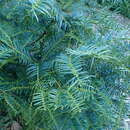Comments
provided by eFloras
An endangered species in China. Records of Cephalotaxus. mannii from Xizang and Yunnan require confirmation; they may be misidentifications of C. fortunei var. alpina. R. R. Mill considers the plants from Hainan (and possibly also those from Guangdong and Guangxi) to be separable as C. hainanensis H. L. Li (Lloydia 16: 164. 1953), which was placed in the synonymy of C. mannii by L. K. Fu (Acta Phytotax. Sin. 22: 281. 1984). Mill’s comparison of the types and other material of both species suggests that they may be distinct taxa, with C. hainanensis differing as follows: leafy branchlets 8-10 × 4.5-5.5 cm in outline (not 11-19(-24) × 6-8(-9.5) cm); leaves borne at 70-80° to branchlet axis (not 45-70° ), parallel sided throughout (not tapered), stomatal bands 0.7-1.3 mm wide (not 1.2-1.6 mm), 2.5-4 × as wide as midvein (not 6-8 × ), apex abruptly and very shortly mucronate (not cuspidate); seed cones solitary (not 2 or 3 together). N. T. Hiep & J. E. Vidal (Fl. Cambodge, Laos et Vietnam 28: 115-118. 1996) concurred with Fu in adopting a broad concept of C. mannii, but identified C. hainanensis as a recognizable entity within the complex. H. L. Li, in the protologue, considered C. hainanensis to be closer to C. sinensis than to C. mannii.
- license
- cc-by-nc-sa-3.0
- copyright
- Missouri Botanical Garden, 4344 Shaw Boulevard, St. Louis, MO, 63110 USA
Description
provided by eFloras
Trees to 20 m tall; trunk to 50(-110) cm d.b.h.; bark light brown to reddish brown, flaking off. Leafy branchlets elliptic or oblong-elliptic in outline, 8-19(-24) × 4.5-8(-9.5) cm, about 1/2 as wide as long. Leaves borne at 45-80° to branchlet axis; petiole ± absent or (0.3-)0.5(-1) mm; blade dark green or shining olive green adaxially, linear or linear-lanceolate, usually straight, occasionally slightly falcate, flat, 1.5-4 cm × 2.5-4 mm, leathery or relatively thin, midvein prominent adaxially, 0.2-0.3 mm wide abaxially, stomatal bands white or bluish white, often indistinct and green when dry because of white powder being shed, 0.7-1.6 mm wide, of 19-23(-26) rows of stomata, 2.5-8 × as wide as midvein, marginal bands 0.1-0.3 mm wide, base very broadly obtuse or obtusely truncate, symmetric or not, margin narrowly revolute, apex cuspidate (with leaf tapered into apex from at least middle, often from base), or abruptly and very shortly mucronate (with leaf parallel sided and mucro 0.1-0.2 mm). Pollen cones borne 6-8 together, pale yellow, globose, 4-4.5 mm in diam.; peduncle (1-)4-5 mm, usually with at least 10 bracts; microsporophylls 7-13, each with 3 or 4 pollen sacs. Seed cones solitary or borne 2 or 3 together; peduncle 6-10 mm. Aril green initially, turning red when ripe, 2.2-3 × 1.1-1.2 cm. Seeds obovoid-ellipsoid or obovoid, sometimes laterally compressed, 2.2-2.8 cm, apex shortly mucronate or cuspidate. Pollination (Nov-)Feb-Mar, seed maturity Aug-Oct. 2n = 24*.
- license
- cc-by-nc-sa-3.0
- copyright
- Missouri Botanical Garden, 4344 Shaw Boulevard, St. Louis, MO, 63110 USA
Distribution
provided by eFloras
SW Guangdong (Xinyi Xian), Guangxi (Rong Xian), Hainan (Jianfeng Ling, Limu Ling, Wuzhi Shan), SE Xizang, S and W Yunnan [NE India, Laos, N Myanmar, N Thailand, N Vietnam]
- license
- cc-by-nc-sa-3.0
- copyright
- Missouri Botanical Garden, 4344 Shaw Boulevard, St. Louis, MO, 63110 USA
Habitat
provided by eFloras
Mixed forests and forested ravines; circa 1100 m.
- license
- cc-by-nc-sa-3.0
- copyright
- Missouri Botanical Garden, 4344 Shaw Boulevard, St. Louis, MO, 63110 USA
Synonym
provided by eFloras
Cephalotaxus griffithii J. D. Hooker; C. hainanensis H. L. Li.
- license
- cc-by-nc-sa-3.0
- copyright
- Missouri Botanical Garden, 4344 Shaw Boulevard, St. Louis, MO, 63110 USA
Cephalotaxus mannii: Brief Summary
provided by wikipedia EN
Cephalotaxus mannii is a species of plant in the family Taxaceae. It is a tree up to about 20 metres (66 ft) tall, native to southern China, northeast India, Laos, northern Thailand, northern Myanmar and northern Vietnam. While the species is widespread, its populations are fragmented and it is threatened by cutting for timber as well as for using its bark and leaves for medicinal extracts.
Sometimes (e.g.) the species Cephalotaxus griffithii and Cephalotaxus hainanensis are considered synonyms of this species.
- license
- cc-by-sa-3.0
- copyright
- Wikipedia authors and editors

